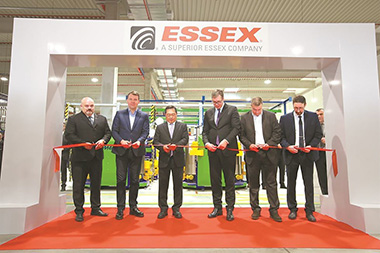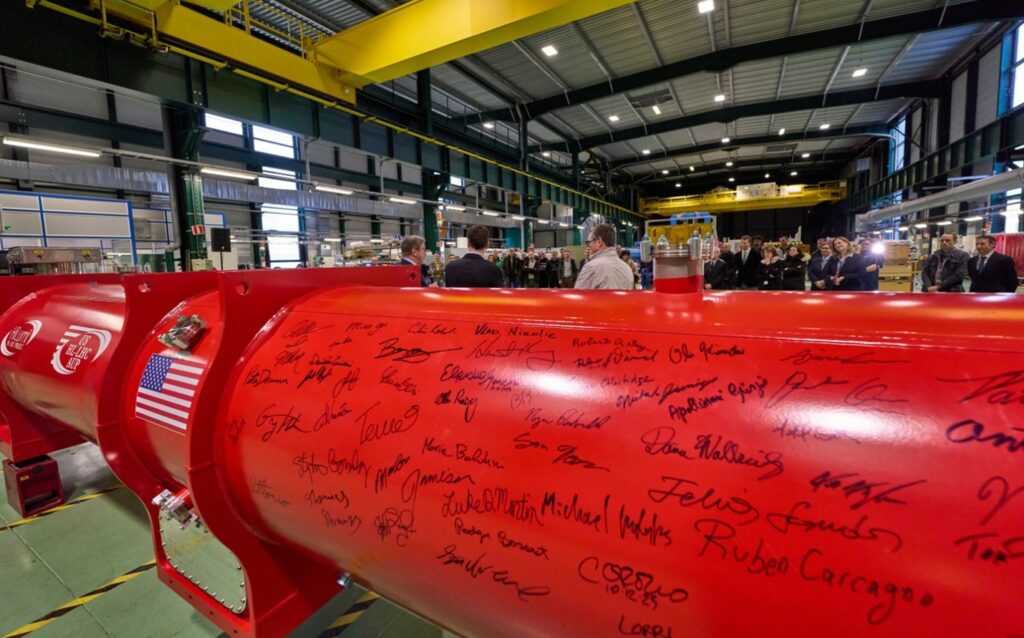
After twenty years of research, development, testing and production, the United States is now shipping state-of-the-art superconducting accelerator magnets to CERN for the high-luminosity upgrade to the Large Hadron Collider in Switzerland. At the heart of these powerful magnets is a new superconducting material used for the first time in a particle accelerator. Earlier, prototypes performed successfully but exhibited shortcomings, however, the dedicated teams of scientists and engineers overcame them with some design and production adjustments.
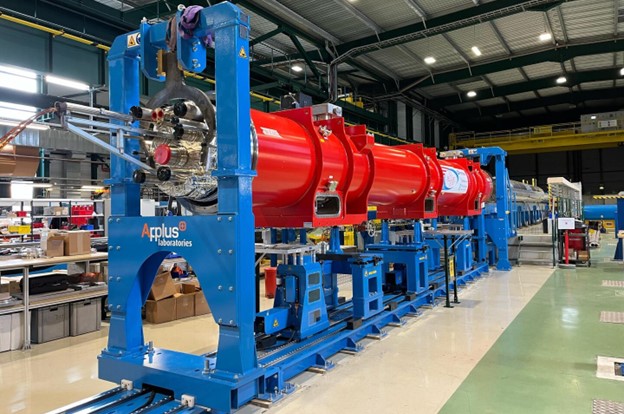
On Dec. 18, the physics laboratory CERN in Geneva, Switzerland, celebrated the arrival of a very large parcel from the United States. Inside was a 13-meter-long assembly comprising two magnets with 4.2-meter-long coils. These are the first U.S.-built magnets for the high-luminosity upgrade to the Large Hadron Collider, or HL-LHC. Over the next few years, another nine assemblies will follow, thus completing a two-decades’ effort by a consortium of U.S. Department of Energy national laboratories – Fermilab, Brookhaven, and Berkeley Lab – to design and build new accelerator focusing magnets. These magnets, along with those from CERN, will be installed around two of the LHC’s collision points in two years’ time.
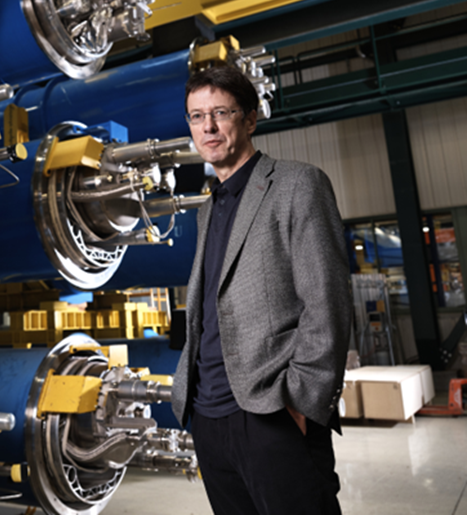
“In the realm of large scientific endeavors like the HL-LHC, global collaboration and expertise play pivotal roles. The delivery of the first cryo-assembly housing fully validated niobium–tin series magnets is a tangible testament to the success of the US Accelerator Upgrade Project,” said Mike Lamont, CERN Director for Accelerators & Technology. “This event not only marks a crucial milestone in our collaboration with our US partners, but also celebrates the outstanding contributions shaping the future landscape of particle physics at CERN.”
Teams at the Department of Energy’s Lawrence Berkeley National Laboratory (Berkeley Lab) play a key role in building the new magnets. This summer, experts in the Accelerator Technology & Applied Physics (ATAP) Division and Engineering Division finished a project to turn superconducting wire into the cables used to make the magnet coils. That’s no easy feat, since each cable is made in one continuous piece made by wrapping 40 individual strands of wire around a stainless-steel core. If even one wire crossed over another anywhere along the entire length – typically 470 meters – the cable would be ruined. Once the cables were transformed into magnet coils at Fermilab and Brookhaven Lab, they returned to Berkeley Lab, where technicians assembled four coils into magnets called quadrupoles.
“These magnets are incredibly challenging to make, so completing the first one and getting it safely to CERN is a huge milestone,” said Soren Prestemon, who leads Berkeley Lab’s contribution to the LHC Accelerator Upgrade Project. “Now we’re focused on finishing the assembly of the remaining magnets, and excited about the discoveries they’ll make possible.”
The Large Hadron Collider smashes protons and other atomic nuclei together at close to the speed of light, recreating conditions that existed shortly after the Big Bang. Scientists study these collisions to learn about subatomic particles and the fundamental laws of physics. They look for answers to some of the biggest questions in physics. What is the nature of dark matter? What happened to all the antimatter? How did particles acquire mass during the early universe?
The magnets built by the U.S. High-Luminosity Accelerator Upgrade Project will tightly squeeze the two proton beams traveling in opposite directions around the LHC just before they collide. This tight squeeze will contribute to increasing the LHC’s collision rate by a factor of 5 over the original design value. Together with other upgrades, it will allow scientists to collect more data much faster than ever before. With these huge data sets, scientists will be able to study extremely rare subatomic events with high precision and explore phenomena beyond what the current LHC capabilities allow.
Upgrading the collision rate is difficult. Scientists needed to create magnets that are strong enough to focus and squeeze the proton beams of the LHC into much tighter bunches as they collide head on. So how are they doing it?
The answer is a rarely used and fussy superconducting material called niobium-3-tin, or Nb3Sn. When cooled with liquid helium to minus 271.25 degrees Celsius, Nb3Sn is an excellent superconductor and transports electricity without resistance. It is a type of superconductor that can reach higher magnetic fields than the standard niobium-titanium currently used in LHC superconducting magnets. The new magnets produce a maximum magnetic field of 12 tesla, roughly 50% more than the strength of the niobium-titanium focusing magnets currently in the Large Hadron Collider.
Scientists had never used Nb3Sn in a large-scale accelerator project because it is extremely difficult to work with.
“It’s brittle like glass,” said Giorgio Apollinari, the head of the HL-LHC accelerator upgrade project at the U.S. Department of Energy’s Fermi National Accelerator Laboratory. “When properly handled, glass can last for centuries, like in a cathedral window, but then one day you knock it, and it breaks. We spent a lot of time figuring out how to treat and handle this material and address its brittleness.”
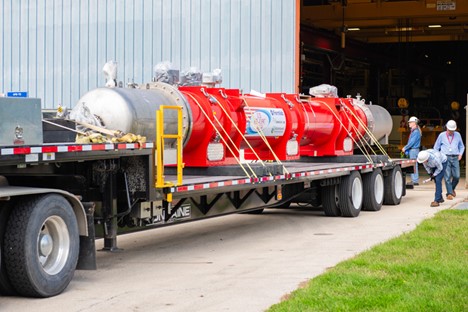
“Designing, building and successfully testing these advanced Nb3Sn magnets with accelerator-quality features is a first for humanity and represents a major progress in accelerator technology,” said Apollinari. “But this initial success is only part of the story.”
Shipping magnets and their components among the U.S. laboratories has been a backbone of the upgrade project. But according to Apollinari, safely sending a 25-ton cryo-assembly around the world is a challenge. “You can’t just go to the store and buy Styrofoam or bubble wrap to package it for shipment,” he said. The magnet needed to arrive at CERN in mint-condition and incur no damage during the transit. So the magnet team started as any good scientific team would: with a dummy-magnet made from 25 tons of concrete and iron, and loaded with sensors.
“We drove a block of concrete around the U.S. and then sent it by ship to CERN,” Apollinari said. “The sensors were so good that we could tell when the truck was going over railroad tracks.” From this data, they were able to design shipping equipment – their special version of “bubble wrap” – and a shipment plan that took into account how much force and acceleration the magnet could tolerate from the turbulence the magnet might experience during its journey.
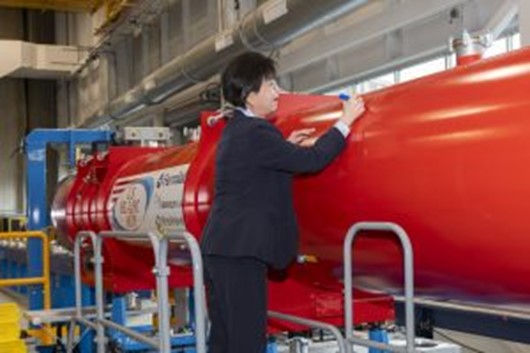
After one month on land and at sea, the real magnet finally arrived at CERN in November 2023, where it is currently being evaluated. Eventually, CERN personnel will install this magnet – along with 7 more from the United States and 8 from CERN – 100 meters underground in the LHC tunnel to focus the particle beams approaching the collision points of the two largest LHC experiments: ATLAS and CMS. The HL-LHC installation will start in 2025, with the plan to start colliding protons with the upgraded machine in 2029.
Said CERN HL-LHC project leader Oliver Bruening, “The arrival of this first cold-mass assembly marks the start of a new phase of the CERN-US collaboration: the delivery of final cryo-assemblies ready for the installation in the LHC.”
Overcoming challenges with the prototypes
“The contribution of our US colleagues has been instrumental in developing the design and procedures for these magnets, and the regular cross-checks of manufacturing and test data have helped the teams on both sides of the Atlantic to overcome many challenges,” said Ezio Todesco, who is in charge of the HL-LHC interaction region magnets for CERN, as he explained in early December.
The CERN Technology department is developing a series of ten magnets (eight, plus two spare), each 7.2 metres in length. This work builds on the HL-LHC Accelerator Upgrade Project (AUP), based in the USA, which is currently manufacturing 20 (16, plus four spares) quadrupole magnets, each 4.2 metres long. Recent tests at Fermilab showed that these magnets operate at target current at both 1.9 kelvin (-71.25 °C) and 4.5 kelvin (-268.65 °C), thus meeting the project requirements. The CERN team is relying on the same design and similar manufacturing procedures as AUP but scaling them up to 7.2-m-long magnets.
The successful test at CERN, which ran from August to October, achieved the target current of 16.53 kA at both 1.9 K and 4.5 K. The target current corresponds to the 7 TeV LHC operation, plus a 300 A margin. Although operation is planned at 1.9 K, the ability to reach target current at 4.5 K confirms design robustness and a comfortable operation margin for the HL-LHC and beyond.
This is the third full-length magnet to be tested as part of a recovery plan decided on after performance limitations were observed on the first two prototypes. The other magnets showed no signs of degradation when tested, but were always limited to below target current when operated at 4.5 K. The team at CERN paused production to investigate this limitation. By improving the design of the outer shell, reducing peak stress on the magnet during coil assembly and changing the parameters of the coil manufacturing process, they eliminated the limitations and the third magnet has outshone its predecessors.
“Thank you to all the contributors for the excellent results and efficient teamwork and for deriving practical and robust engineering solutions to bring niobium–tin technology to the maturity level required for accelerator magnet applications,” says Arnaud Devred, the TE-MSC group leader. “This is a fantastic result for the project,” says Oliver Brüning, HL-LHC project leader. “It means that niobium–tin is viable for 7-m-long accelerator magnets and is an enabling technology for HL-LHC.”
For more info, see www.energy.gov/science, www.home.cern.

